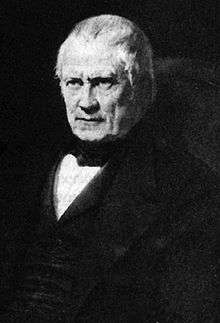Henri Marie Ducrotay de Blainville
| Henri Marie Ducrotay de Blainville | |
|---|---|
 | |
| Born |
12 December 1777 Arques-la-Bataille, France |
| Died |
1 May 1850 (aged 72) Paris, France |
| Nationality | French |
| Scientific career | |
| Fields | |
| Institutions |
Collège de France French Academy of Sciences |
Henri Marie Ducrotay de Blainville (12 September 1777 – 1 May 1850) was a French zoologist and anatomist.
Life
Blainville was born at Arques, near Dieppe. As a young man he went to Paris to study art, but ultimately devoted himself to natural history. He attracted the attention of Georges Cuvier, for whom he occasionally substituted as lecturer at the Collège de France and at the Athenaeum Club, London. In 1812 he was aided by Cuvier in acquiring the position of assistant professor of anatomy and zoology in the Faculty of Sciences at Paris. Eventually, relations between the two men soured, a situation that ended in open enmity.[1]
In 1825 Blainville was admitted a member of the French Academy of Sciences; and in 1830 he was appointed to succeed Jean-Baptiste Lamarck in the chair of natural history at the museum. Two years later, on the death of Cuvier, he obtained the chair of comparative anatomy, of which he proved himself a worthy successor to his former teacher.[1] In 1837, he was elected a foreign member of the Royal Swedish Academy of Sciences. On May 1, 1850, he died from an attack of apoplexy in a railway carriage at the Embarcadère du Havre (current Gare Saint-Lazare) in Paris.[2]
He was the taxonomic authority of numerous zoological species, extinct and extant; including the eponymous Blainville's beaked whale, Mesoplodon densirostris.
In the field of herpetology, he adopted Pierre André Latreille's proposal of separating Amphibia from Reptilia, and then (1816) developed a unique arrangement in regards to sub-groupings, using organs of generation as primary criteria.[3][4] He described several new species of reptiles.[5]
Blainville rejected evolution. He was a critic of Lamarck's evolutionary ideas but similar to Lamarck proposed a great chain of being.[6][7]
It was in 1822 that he coined the term paleontology.
Legacy
Blainville is commemorated in the scientific name of a North American lizard, Phrynosoma blainvillii.[8]
Selected writings
- Sur les ichthyolites, ou, Les poissons fossiles (1818) - On "ichthyolites", or fossil fish.
- De l'organisation des animaux, ou Principes d'anatomie comparée (1822) - On the organization of animals, or principles of comparative anatomy.
- Manuel de malacologie et de conchyliologie (1825-1827) - Manual of malacology and conchology.
- Cours de physiologie générale et comparée (1829) - Course of general and comparative physiology.
- Manuel d'actinologie, ou de zoophytologie (1834) - Manual of actinology [the study of the chemical effects of visible and ultraviolet light] or zoophytology.
- Ostéographie ou description iconographique comparée du squelette et du système dentaire des mammifères récents et fossiles (1839–64) - Osteography or comparative iconographical descriptions of the skeleton and teeth of living and fossil mammals.[9]
References
- 1 2 Chisholm 1911.
- ↑ Du jardin au Muséum en 516 biographies / Philippe Jaussaud ; Edouard-Raoul Brygoo .- Paris : Muséum national d'histoire naturelle, 2004 .- pp. 169-170 Archived 2014-02-21 at the Wayback Machine. (Archives)
- ↑ Encyclopædia Britannica, 9th ed. (1878) Amphibia
- ↑ Google Books Report of the Annual Meeting, Volume 4, Part 1835 by British Association for the Advancement of Science. Meeting
- ↑ "Blainville". The Reptile Database. www.reptile-database.org.
- ↑ Appel, Toby A. (1980). Henri De Blainville and the Animal Series: A Nineteenth-Century Chain of Being. Journal of the History of Biology 13 (2): 291-319.
- ↑ Desmond, Adrian. (1989). The Politics of Evolution: Morphology, Medicine, and Reform in Radical London. University of Chicago Press. p. 52. ISBN 0-226-14374-0 "As early as 1816 Henri de Blainville, professor of zoology at the faculty of sciences, had adopted Lamarck's animal series, with its spontaneously generated base (although without accepting his transformism)"
- ↑ Beolens, Bo; Watkins, Michael; Grayson, Michael (2011). The Eponym Dictionary of Reptiles. Baltimore: Johns Hopkins University Press. xiii + 296 pp. ISBN 978-1-4214-0135-5. ("Blainville", p. 26).
- ↑ Works by or about Henri Marie Ducrotay de Blainville in libraries (WorldCat catalog)
- Attribution
